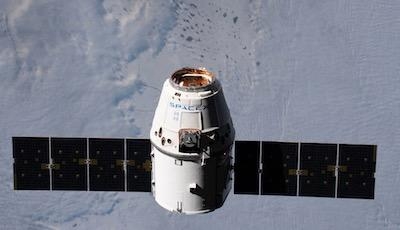Will Return Experiments And Other Cargo To Earth January 6
Filled with almost 3,600 pounds of valuable scientific experiments and other cargo, a SpaceX Dragon resupply spacecraft is set to leave the International Space Station Sunday, Jan. 5.

Robotic flight controllers at mission control in Houston will issue remote commands at 9:41 p.m. to release Dragon using the station’s Canadarm2 robotic arm. Expedition 61 Station Commander Luca Parmitano of ESA (European Space Agency) will back up the ground controllers and monitor Dragon’s systems as it departs the orbital laboratory.
Dragon will fire its thrusters to move a safe distance from the station, then execute a deorbit burn as it heads for a parachute-assisted splashdown around 3:04 a.m. Monday, Jan. 6, in the Pacific Ocean southwest of Long Beach, California.
A key component returning aboard Dragon is a faulty battery charge-discharge unit (BCDU), which failed to activate following the Oct. 11 installation of new lithium-ion batteries on the space station’s truss. Expedition 61 flight engineers Christina Koch and Jessica Meir of NASA removed and replaced the BCDU was during a spacewalk Oct. 18. The unit will be returned to teams on Earth for evaluation and repair.
Dragon launched on the SpaceX Falcon 9 rocket Dec. 5 from Space Launch Complex 40 at Cape Canaveral Air Force Station in Florida and arrived at the space station two days later.
Some of the scientific investigations Dragon will return to Earth include:
Tiny Radiation Resistors
Rotifer-B1 examines the effects of spaceflight on tiny aquatic animals, called rotifers, which are found in freshwater ecosystems and soil and are highly resistant to radiation on Earth. The investigation specifically looks at the metabolism and genome of the rotifer Adineta vaga to determine whether they have similar adaptation mechanisms in microgravity.
Mice in Space
Rodent Research-19 examines myostatin and activin, molecular signaling pathways that influence muscle degradation, as possible targets for preventing muscle and bone loss during spaceflight and enhancing recovery following return to Earth. This study also could support the development of therapies for a wide range of conditions that cause muscle and bone loss on Earth.
Finding the Perfect Solution
On Earth, our bodies deal with low-level radiation through a naturally occurring protein that helps our body safely process it. The Growth of Large, Perfect Protein Crystals for Neutron Crystallography (Perfect Crystals) study, aims to help scientists find a way to deal with the problem of radiation during long-duration spaceflight missions using the same protein that is already at work in our bodies.
Convection and Crystallization in Microgravity
The Polymer Convection study examines the effects of gravity on formation and crystallization of Broadband Angular Selective Material (BASM), an optical material with the ability to control the reflection and absorption of light. BASM has applications in polymer packaging, optical films, solar power and electronic displays.
These are just a few of the hundreds of investigations providing opportunities for U.S. government agencies, private industry, and academic and research institutions to conduct microgravity research that leads to new technologies, medical treatments and products that improve life on Earth. Conducting science aboard the orbiting laboratory will help us learn how to keep astronauts healthy during long-duration space travel and demonstrate technologies for future human and robotic exploration beyond low-Earth orbit to the Moon and Mars.
(Image provided with NASA news release)
 ANN's Daily Aero-Term (05.29.25): Terminal Radar Service Area
ANN's Daily Aero-Term (05.29.25): Terminal Radar Service Area ANN's Daily Aero-Term (05.30.25): Very High Frequency (VHF)
ANN's Daily Aero-Term (05.30.25): Very High Frequency (VHF) Aero-News: Quote of the Day (05.30.25)
Aero-News: Quote of the Day (05.30.25) Airborne 05.23.25: Global 8000, Qatar B747 Accepted, Aviation Merit Badge
Airborne 05.23.25: Global 8000, Qatar B747 Accepted, Aviation Merit Badge ANN's Daily Aero-Linx (05.30.25)
ANN's Daily Aero-Linx (05.30.25)



